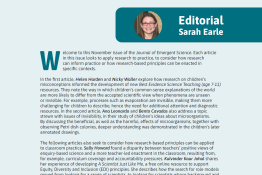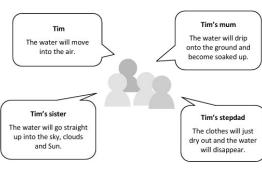Assessing the impact of an enquiry-based learning intervention on primary school students’ conceptions about microorganisms
Issue 29 | Page 15 | Published Nov 2025
Description
Abstract
Microorganisms are almost ubiquitous, but their small size often makes them difficult for children to conceptualise. This study aimed to assess the impact of an enquiry-based learning intervention on the conceptions of primary school students (ages 9-10) regarding microorganisms. The intervention included practical activities involving the cultivation of microorganisms in Petri dishes, collected from various surfaces. The students’ ideas were gathered through drawings and their descriptions before and after the intervention. The results indicated that, post-intervention, the association of bacteria and viruses with microorganisms increased, demonstrating a deeper understanding of specific types of microorganisms. Additionally, there was an increased awareness of the actions of microorganisms, with students illustrating specific diseases caused by them, as well as recognising their general and specific beneficial effects on humans.
References
Ballesteros, M.I., Paños, E. & Ruiz-Gallardo, J.R. (2018) ‘Los microorganismos en la educación primaria: ideas de los alumnos de 8 a 11 años e influencia de los libros de texto’, Enseñanza de las Ciencias, 36, (1), 79–98. https://doi.org/10.5565/rev/ensciencias.2274
Brown, S. (2002) Experimentos de ciencias en educacion infantil. Madrid: Narcea
Byrne, J. & Sharp, J. (2006) ‘Children’s ideas about micro-organisms’, School Science Review, 88, (322), 71–79. http://eprints.soton.ac.uk/id/eprint/41812
Byrne, J., Grace, M. & Hanley, P. (2009) ‘Children’s anthropomorphic and anthropocentric ideas about micro-organisms’, Journal of Biological Education, 44, (1), 37–43. https://doi.org/10.1080/00219266.2009.9656190
Byrne, J. (2011) ‘Models of micro-organisms: children’s knowledge and understanding of micro-organisms from 7 to 14 years old’, International Journal of Science Education, 33, (14), 1927–1961. https://doi.org/10.1080/09500693.2010.536999
Carvalho, G.S., Mafra, P. & Lima, N. (2017) ‘Children’s conceptions about microorganism and health’. In: Electronic Proceedings of the ESERA 2017 Conference. Research, Practice and Collaboration in Science Education, Part 16, Kariotoglou, P. & Russell, T. (Co-Eds.), pps. 2122–2129. Dublin: Dublin City University. https://hdl.handle.net/1822/56941
Faccio, E., Costa, N., Losasso, C., Cappa, V., Mantovani, C., Cibin, V., Andrighetto, I. & Ricci, A. (2013) ‘What programs work to promote health for children? Exploring beliefs on microorganisms and on food safety control behavior in primary schools’, Food Control, 33, (2), 320–329. https://doi.org/10.1016/j.foodcont.2013.03.005
Gonçalves, P. (2012) Os microrganismos no 1. º e 2. º ciclos do ensino básico: abordagem curricular, conceções alternativas e propostas de atividades experimentais. [Tese de Doutoramento, Instituto Politécnico de Bragança, Bragança, Portugal]. Biblioteca Digital do Instituto Politécnico de Bragança. http://hdl.handle.net/10198/8759
Jones, M.G. & Rua, M.J. (2006) ‘Conceptions of germs: Expert to novice understandings of microorganisms’, Electronic Journal of Science Education, 10, (3). https://ejrsme.icrsme.com/article/view/7741
Karadon, H.D. & Sahin, N. (2010) ‘Primary school students’ basic knowledge, opinions and risk perceptions about microorganisms’, Procedia Social and Behavioral Sciences, (2), 4398–4401. https://doi.org/10.1016/j.sbspro.2010.03.700
Mafra, P. & Lima, N. (2009) ‘The microorganisms in the Portuguese national curriculum and primary school textbooks’. In: Current research topics in applied microbiology and microbial biotechnology, Mendez-Vilas, A. (Ed.), pps. 625–629. London: World Scientific. https://doi.org/10.1142/9789812837554_0130
Mafra, P., Lima, N. & Carvalho, G.S. (2014) ‘Experimental Activities in Primary School to Learn about Microbes in an Oral Health Education Context’, Journal of Biological Education, 49, (2), 190–203. https://doi.org/10.1080/00219266.2014.923485
Marcos-Merino, J.M., Gallego, R.E. & Ochoa de Alda, J.G. (2019) ‘Formando a futuros maestros para abordar los microorganismos mediante actividades prácticas. Papel de las emociones y valoraciones de los estudiantes’, Revista Eureka sobre Enseñanza y Divulgación de las Ciencias, 16, (1), 1602. https://doi.org/10.25267/Rev_Eureka_ensen_divulg_cienc.2019.v16.i1.1602
Nagy, M.H. (1953) ‘The representation of “germs” by children’, The Pedagogical Seminary and Journal of Genetic Psychology, (83), 227–240.
https://doi.org/10.1080/08856559.1953.10534089
Parker, N., Schneegurt, M., Tu, A.-H.T., Forster, B.M. & Lister, P. (2018) Microbiology. OpenStax™
Pedaste, M., Mäeots, M., Siiman, L.A., de Jong, T., Van Riesen, S.A., Kamp, E.T., Manoli, C.C., Zacharia, Z.C. & Tsourlidaki, E. (2015) ‘Phases of inquiry based learning: definitions and the inquiry cycle’, Educational Research Review, (14), 47–61
Redfern, J., Burdass, D. & Verran, J. (2013) ‘Practical microbiology in schools: a survey of UK teachers’, Trends in microbiology, 21, (11), 557–559
Ruiz-Gallardo, J.R. & Paños, E. (2018) ‘Primary school students’ conceptions about microorganisms. Influence of theoretical and practical methodologies on learning’, Research in Science & Technological Education, 36, (2), 165–184. https://doi.org/10.1080/02635143.2017.1386646
Simard, C. (2021) ‘Microorganism education: misconceptions and obstacles’, Journal of Biological Education, 57, (2), 308–316. https://doi.org/10.1080/00219266.2021.1909636
Xu, Y., Ding, X., Wang, W. & Li, Y. (2024) ‘Analysis of ten-year teaching evaluation of oral microbiology lab curriculum’, BMC Medical Education, 24, (309), 1–10. https://doi.org/10.1186/s12909-024-05298-1
More from this issue
Abstract
The Best Evidence Science Teaching (BEST) (7-11) ‘Materials and their properties’ resources have been developed by...




